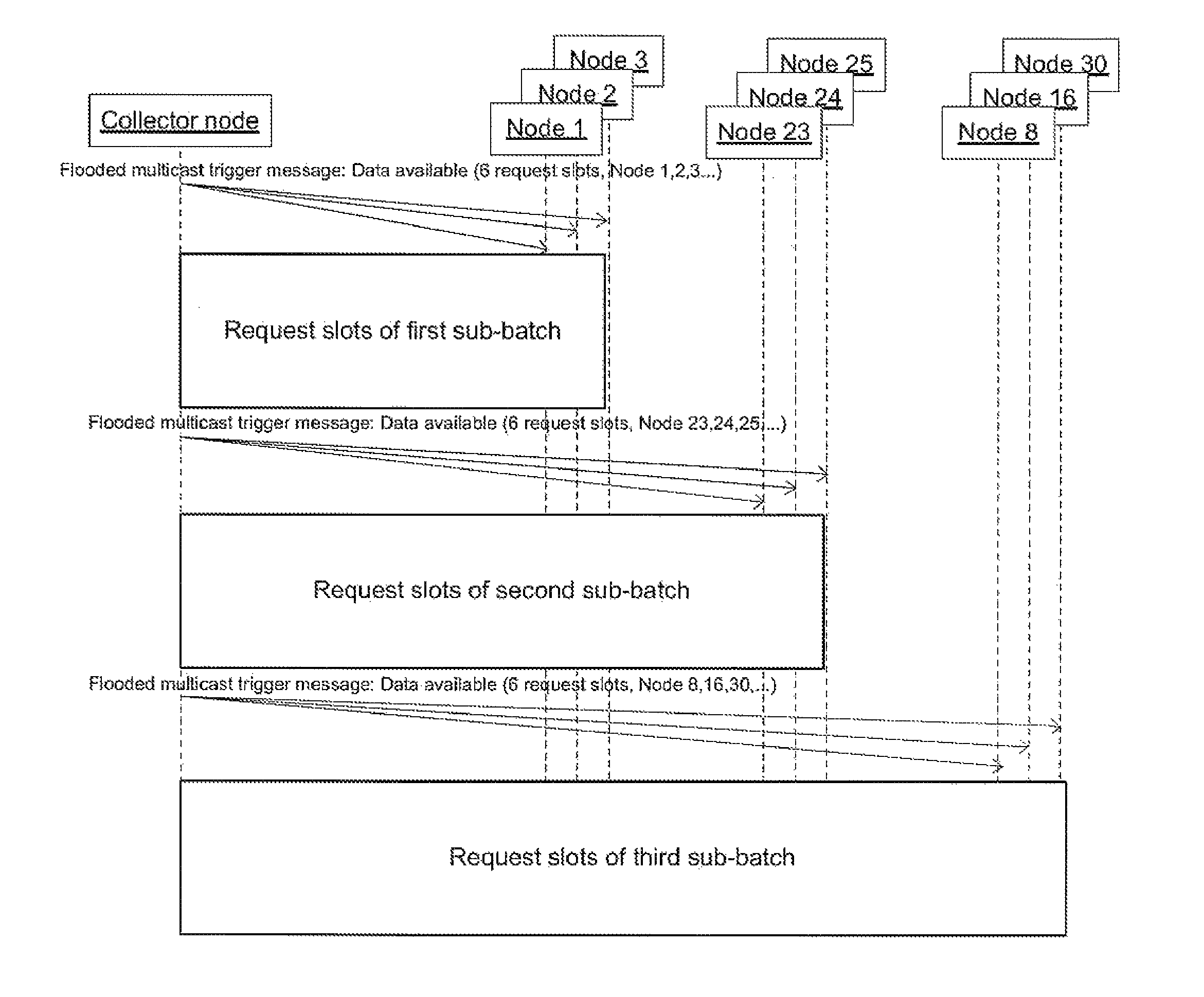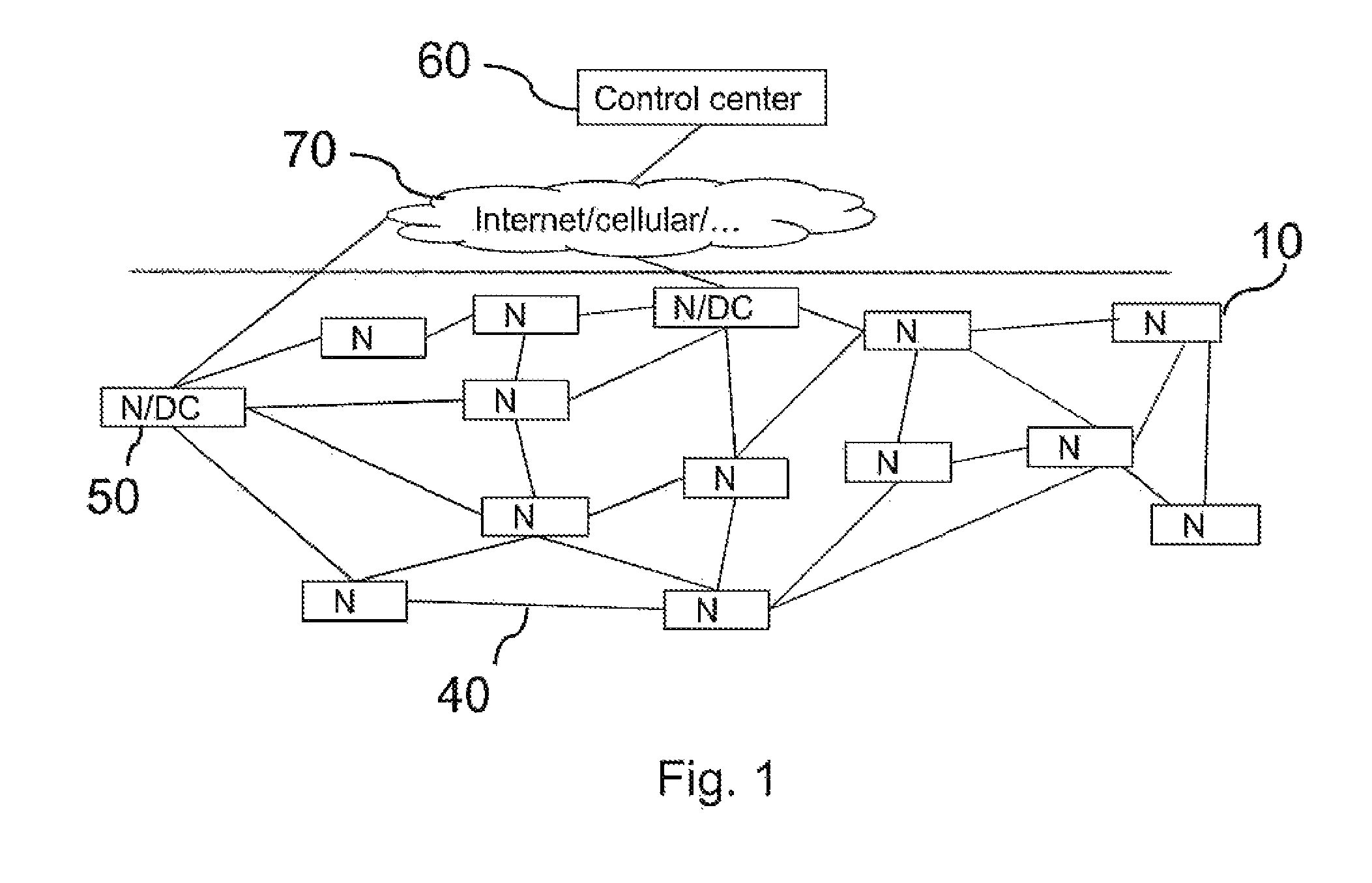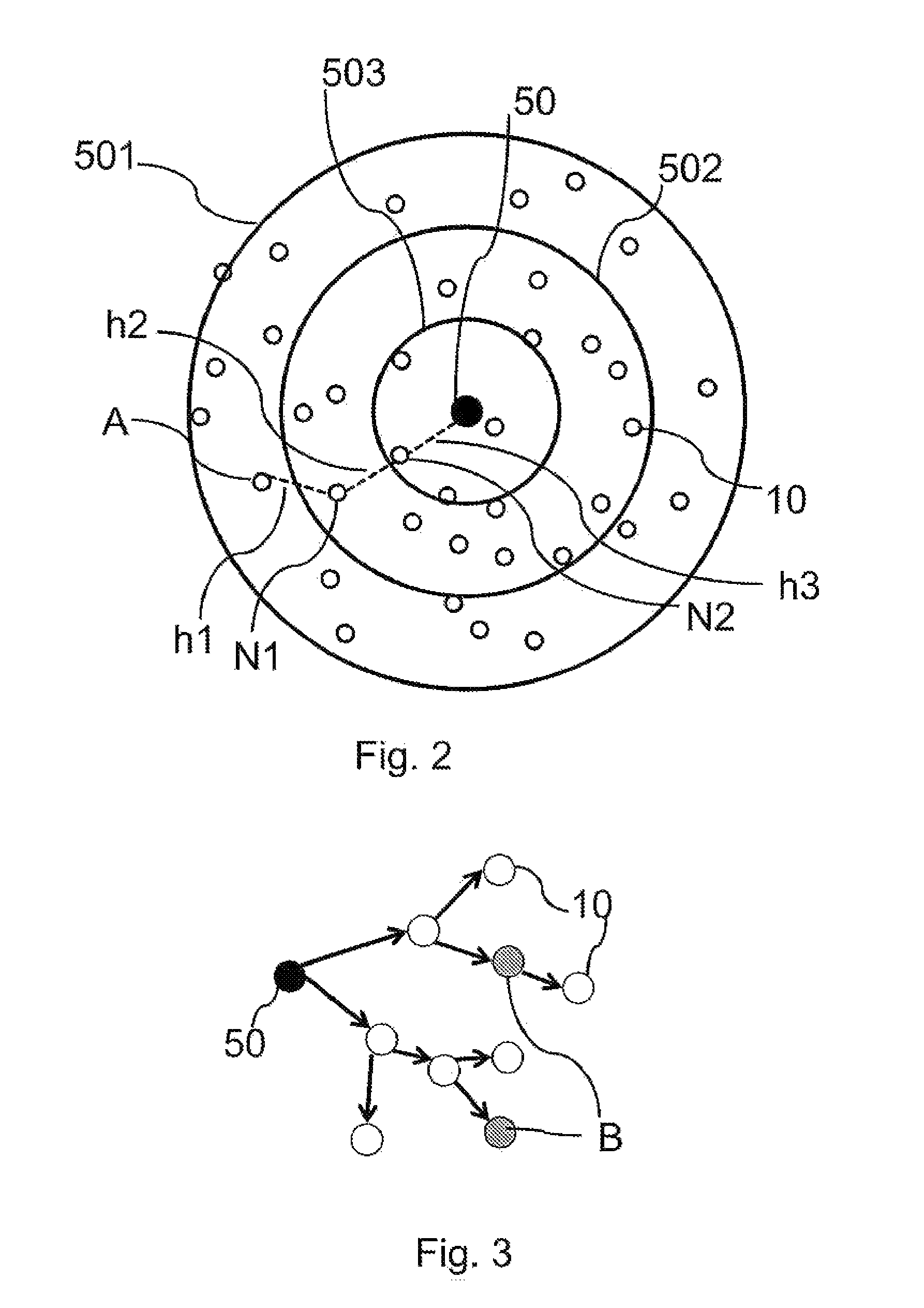[0009]In view of above disadvantages and problems in the prior art, it is an object of the present invention to provide a system and a method for transmitting data packets in a wireless network, wherein data packet transmission from a collector node to one or more network nodes is improved, without additional routing protocols or increasing the overall network load.
[0011]According to one aspect of the present invention, a system for controlling data packet transmission in a wireless network is provided comprising a plurality of nodes and at least one collector node that may function as a gateway to a control center. When (or after) a node or a collector node receives a data packet directed or addressed to the collector node, this node or collector node stores for a predetermined time at least information about the sender node and about the transmitting node as reverse-route information. Data packet transmission in the wireless mesh network is preferably performed in a multi-hop mode. Thus, in case that the receiving node is not the collector node, the receiving node may be an intermediate or forwarding node in a multi-hop transmission. At least one of the sender node information and the transmitting node information may be included in the received uplink data packet. The sender node information may relate to an address or other identifying information for the node that has initiated the transmission of the data packet. Likewise, the transmitting node information may relate to an address or identifying information for the previous node, from which the data packet has been received. Preferably, the sender node information is temporarily stored as destination node information and the transmitting node information is temporarily stored as receiving node information in a route cache of the receiving node. If receiving a downlink data packet directed to the sender node of the uplink data packet, while the reverse-route information is being cached, the node may use the reverse-route information for forwarding the downlink data packet. By these means, a downlink data packet can be transmitted the reverse way as the uplink data packet. Since, in general, the uplink transmission follows a very efficient routing protocol, the downlink transmission can be improved this way, without requiring additional routing protocols or full routing information included in the downlink data packet. Thus, the idea of the invention relates to reverse-route caching.
[0012]The wireless network may have mesh topology, wherein each node may act as a router. Such a network has increased redundancy and reliability. Preferably, the nodes of the wireless network are stationary, as it is mainly the case for large outdoor lighting systems. Alternatively or additionally, the positions of at least some nodes may be known to at least some of the other nodes of the network. For instance, at least some of the nodes may store a routing table for uplink transmissions to a closest collector node. For uplink transmission, a routing protocol for data packet transmission to the collector node (“sink”) may be based on sink-distance vector routing, also called many-to-one routing. Hence, a data packet is transmitted to the neighboring node that is closer to one of the collector nodes. By these means, data packet transmission becomes faster and more efficient. Moreover, this also allows to dispense with a large number of collector nodes in large wireless mesh networks, e.g. with a number of nodes exceeding 1000. Alternatively or additionally, routing tables may be stored at each node comprising routing information for forwarding an uplink data packet to the closest collector node. The uplink data packets may include reporting data related to at least one of detected events, sensor data and status data. For instance, in a lighting system, the luminaire nodes may report regularly a power status, ambience brightness detected by light sensors, operation status and the like.
[0019]In another embodiment, the collector node may be adapted to transmit a trigger message to one or more nodes, in order to create the respective reverse route information. For instance, the trigger message may relate to a notifying message that data is available at the collector node. The trigger message may be sent as a broadcast to all nodes or as a multicast to a group of nodes. The trigger message may be transmitted in flooding mode, wherein all nodes forward the message to every neighbor node except for the transmitting node, from which the message was received. After having received the trigger message, a node may send a data request to the collector node within a time interval specified in the trigger message. Preferably, the uplink transmission of the data request is performed as a routed unicast transmission. In response to the data request from the node, the collector node may transmit the requested data via the reverse route of the data request using the cached reverse-route information. By these means, it can be dispensed with flooded unicast transmissions for transmitting the data to each single node, thus avoiding excessive network load.
[0020]Moreover, by including a time interval in the trigger message, within which the nodes receiving the trigger message have to transmit their data requests, the data traffic can be shaped in respect of time. Preferably, the nodes randomly select a time-slot within the specified time interval for transmitting their data requests. By these means, the data requests of the plurality of nodes can be administered evenly throughout the time interval. Therefore, a data request storm at the collector node and a resulting overload of the network at the collector node or in its neighborhood can be avoided. Consequently, data packet collision and subsequent data packet loss can be prevented.
[0023]The system according to the present invention is particularly suited for a lighting system, since there, most data traffic is directed from the luminaire nodes to the collector node (N:1-traffic) and transmissions from the collector node to the luminaire nodes (1:N-traffic) occur less often. Due to reverse-route caching, data packet transmission from a collector node to other nodes can be improved, while keeping the system simple with respect to network setup and maintenance. Thus, in a preferred embodiment, at least some of the nodes and / or the collector node are associated with luminaire nodes of a lighting system. Furthermore, the system according of the present invention may be used in telemanagement of a lighting system, e.g. for switching on / off luminaire nodes, for controlling dimming patterns of luminaire nodes and / or for reporting data from the luminaire nodes. Employing a system according to the present invention for telemanagement of a lighting system will result in a high-performance lighting system with high scalability.
 Login to View More
Login to View More  Login to View More
Login to View More 


